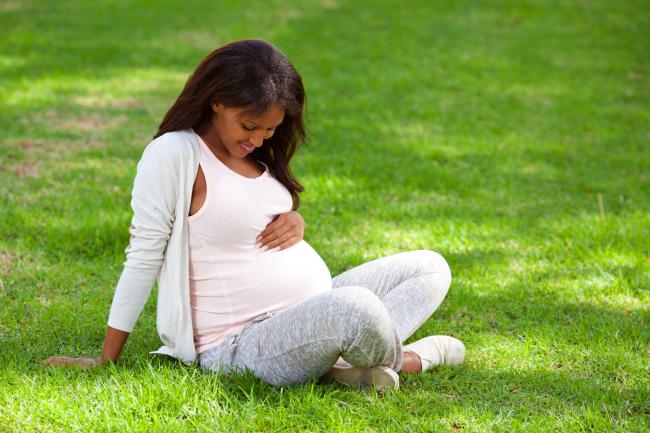Microbiome influences risk of preterm birth
June 11, 2019
Microbiome influences risk of preterm birth
At a Glance
- Researchers found that the vaginal microbiome changes substantially during pregnancy.
- The patterns of changes early in pregnancy may help identify women at high risk for preterm birth.

Our bodies host trillions of bacteria, viruses, and fungi. This teeming population is known as the microbiome.
As scientists have learned over the last two decades, the microbiome can influence how our bodies work. To better understand how these microbial communities affect health and disease, NIH launched the Human Microbiome Project (HMP) in 2007. The first phase of the project aimed to identify and sequence the genomes of many of these common microbes.
The second phase, called the integrative HMP, has been mapping how these microbes interact with the cells of our body and how these interactions change over time.
As part of this project, researchers led by Drs. Jennifer Fettweis and Gregory Buck from Virginia Commonwealth University studied how the vaginal microbiome changes during pregnancy. They also measured how such shifts correlate with the risk of preterm birth.
More than 10% of births in the U.S. are premature. In some groups of women, this rate is even higher. For example, among African-American women, 14% of births are preterm.
The team examined the microbiome in samples collected over time from more than 1,500 women from a diverse population. The researchers then performed a deeper analysis of 45 women who experienced pre-term birth and 90 who gave birth after a normal-length pregnancy. More than three-quarters of those participants were African-American. The study was supported by several NIH components. Results were published on May 29, 2019, in Nature Medicine.
The researchers found that women with a vaginal microbiome dominated by a Lactobacillus species called Lactobacillus crispatus had a lower risk of preterm birth. These bacteria create an acidic environment in the vagina, which may protect it and the womb against harmful microbes. African-American women were less likely to have L. crispatus in their vaginal microbiomes, which may help to explain the racial disparities in preterm birth rates.
The team also identified a set of potentially harmful microbes whose presence was associated with an increased risk of preterm birth. The presence of some of these species correlated with higher levels of molecules that promote inflammation in the body. Inflammation can be a trigger for premature labor.
In an accompanying paper, the team detailed how the vaginal microbiome changes during pregnancies carried to term. African-American women started off with a more diverse microbiome and tended to experience greater shifts in the microbiome early in pregnancy than women of Hispanic or European descent. Lactobacillus species came to dominate as pregnancy progressed. Late in pregnancy, African-American women were about as likely to have Lactobacillus dominate as the other women.
“We hope to be able to use this microbiome data, coupled with clinical and other observations, to develop a predictive model for preterm birth that will allow us to more accurately identify women with higher risk early in pregnancy,” Buck says.
It may be possible to develop a test of the vaginal microbiome that could guide interventions to reduce the risk of preterm birth.
Related Links
- Skin Microbes Fairly Stable Over Time
- Gut Microbes Linked to Rheumatoid Arthritis
- Gut Microbes and Diet Interact to Affect Obesity
- The Healthy Human Microbiome
- The Microbes of Men
- Reference Genomes Advance Human Microbiome Studies
- Human Microbiome Project
References
The vaginal microbiome and preterm birth. Fettweis JM, Serrano MG, Brooks JP, Edwards DJ, Girerd PH, Parikh HI, Huang B, Arodz TJ, Edupuganti L, Glascock AL, Xu J, Jimenez NR, Vivadelli SC, Fong SS, Sheth NU, Jean S, Lee V, Bokhari YA, Lara AM, Mistry SD, Duckworth RA 3rd, Bradley SP, Koparde VN, Orenda XV, Milton SH, Rozycki SK, Matveyev AV, Wright ML, Huzurbazar SV, Jackson EM, Smirnova E, Korlach J, Tsai YC, Dickinson MR, Brooks JL, Drake JI, Chaffin DO, Sexton AL, Gravett MG, Rubens CE, Wijesooriya NR, Hendricks-Muñoz KD, Jefferson KK, Strauss JF 3rd, Buck GA. Nat Med. 2019 May 29. doi: 10.1038/s41591-019-0450-2. [Epub ahead of print]. PMID: 31142849.
Racioethnic diversity in the dynamics of the vaginal microbiome during pregnancy. Serrano MG, Parikh HI, Brooks JP, Edwards DJ, Arodz TJ, Edupuganti L, Huang B, Girerd PH, Bokhari YA, Bradley SP, Brooks JL, Dickinson MR, Drake JI, Duckworth RA 3rd, Fong SS, Glascock AL, Jean S, Jimenez NR, Khoury J, Koparde VN, Lara AM, Lee V, Matveyev AV, Milton SH, Mistry SD, Rozycki SK, Sheth NU, Smirnova E, Vivadelli SC, Wijesooriya NR, Xu J, Xu P, Chaffin DO, Sexton AL, Gravett MG, Rubens CE, Hendricks-Muñoz KD, Jefferson KK, Strauss JF 3rd, Fettweis JM, Buck GA. Nat Med. 2019 May 29. doi: 10.1038/s41591-019-0465-8. [Epub ahead of print]. PMID: 31142850.
Funding
NIH’s Common Fund, National Institute of Allergy and Infectious Diseases (NIAID), Eunice Kennedy Shriver National Institute of Child Health and Human Development (NICHD), National Center for Complementary and Integrative Health (NCCIH), and Office of Research on Women’s Health (ORWH); Global Alliance to Prevent Prematurity and Stillbirth; National Science Foundation.


